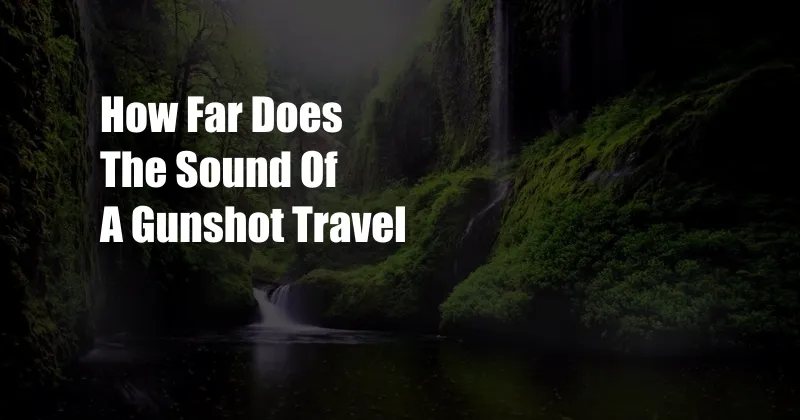
How Far Does the Sound of a Gunshot Travel?
In the eerie stillness of a quiet night, the piercing crack of a gunshot shattered the peace. The sound echoed through the emptiness, carrying with it a sense of danger and foreboding. As the reverberations faded into the distance, I couldn’t help but wonder—just how far did that sound travel?
The answer to this question depends on several factors, including the type of firearm, the surrounding environment, and atmospheric conditions. But before we delve into the specifics, let’s first explore the nature of sound and how it propagates.
Sound: The Basics
Sound is a mechanical wave that travels through a medium, such as air or water. It consists of vibrations that propagate outward from the source, causing fluctuations in the pressure of the medium. The speed of sound in air is approximately 343 meters per second (1,235 kilometers per hour) at sea level and room temperature.
The intensity of sound is measured in decibels (dB). A gunshot can produce a sound intensity of over 140 dB, which can cause temporary or permanent hearing damage. However, the sound intensity decreases with distance as the energy of the sound waves dissipates.
Factors Affecting the Distance a Gunshot Travels
The following factors influence the distance a gunshot travels:
- Firearm Type: Larger caliber firearms generally produce louder sounds that travel farther.
- Ammunition: The type of ammunition used can also affect the sound level and distance it travels.
- Environment: Dense vegetation, buildings, and other obstacles can absorb or deflect sound waves, reducing the distance they travel. Conversely, open spaces and reflective surfaces can amplify and extend the range of the sound.
- Atmospheric Conditions: Temperature, humidity, and wind direction can affect the speed and direction of sound propagation. For example, sound waves travel faster in warm, humid air than in cold, dry air. Additionally, wind can carry sound waves downwind, extending their reach.
Estimates of Gunshot Travel Distances
Based on the factors mentioned above, the following estimates provide a general idea of how far a gunshot might travel:
In a typical outdoor environment, the sound of a gunshot from a small-caliber firearm can travel up to a few kilometers. However, in optimal conditions, such as over open water or in a flat, unobstructed area, the sound can carry for several tens of kilometers.
On the other hand, in a densely populated urban area with numerous buildings and other obstacles, the sound of a gunshot may be absorbed or deflected, reducing its effective range to a few hundred meters or less.
Implications and Precautions
Understanding how far a gunshot travels is essential for both public safety and hunting. For instance, it can help law enforcement officers determine the approximate distance to a shooting incident, and it can guide hunters in safely discharging their firearms without disturbing others.
It’s also important to note that gunshots can be highly disruptive and frightening, even at a distance. Therefore, it’s crucial to discharge firearms responsibly, taking into account the potential range of the sound and its impact on others.
Tips for Mitigating Gunshot Noise
There are several ways to reduce the noise of gunshots, including:
- Using a Suppressor: A suppressor, also known as a silencer, can significantly reduce the sound intensity of a gunshot.
- Shooting in Designated Areas: Firing ranges or private property with ample open space can help minimize noise disruption.
- Wearing Hearing Protection: Earplugs or earmuffs are essential for protecting hearing when shooting.
- Educating Others: Communicating the potential noise impact of firearms can help raise awareness and foster responsible behavior.
FAQ on Gunshot Sound Travel Distance
Q: How far can a gunshot be heard at night?
A: In ideal conditions, the sound of a gunshot can be heard for several kilometers at night, when there is less ambient noise.
Q: Can a gunshot be heard through walls?
A: It depends on the material and thickness of the walls. Dense materials like concrete can block most gunshot sounds, while thin or hollow walls may allow some sound to pass through.
Q: Is it possible to pinpoint the location of a gunshot based on its sound?
A: Yes, it is possible using specialized equipment and techniques, such as acoustic triangulation. Law enforcement agencies often employ these methods to locate the origin of gunshots.
Q: What are the effects of repeated exposure to gunshot noise?
A: Continuous exposure to loud gunshot sounds can lead to hearing damage, tinnitus, and other health issues. It’s crucial to protect your hearing by using proper ear protection.
Conclusion
The distance a gunshot travels is influenced by a complex interplay of factors. While it can be challenging to determine an exact distance, understanding the principles of sound propagation and the impact of environmental conditions can provide valuable insights. This knowledge can contribute to responsible firearm usage, enhance public safety, and promote noise reduction measures.
If you are interested in learning more about the topic of gunshot sound travel distance, consider conducting your own research or consulting with experts in the field. By delving deeper into this subject, you can gain a comprehensive understanding of the science behind sound and its practical implications.